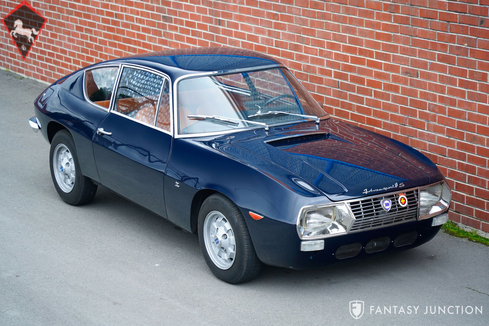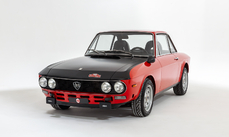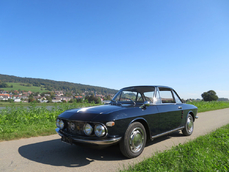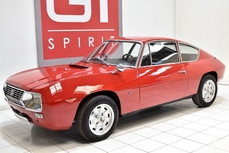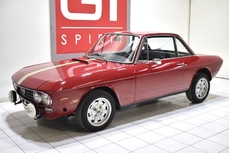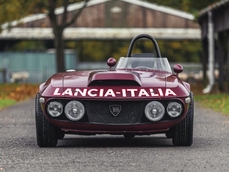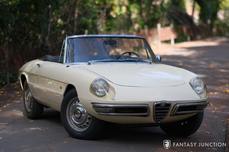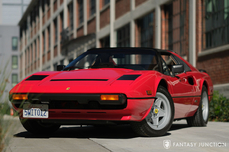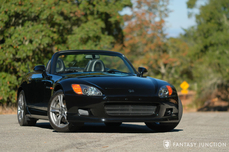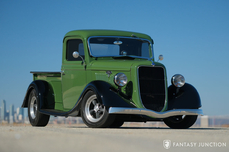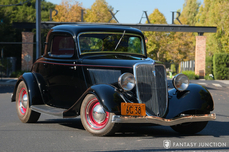Lancia Fulvia 1300cc V4 1972
Allmän beskrivning :
1972 Lancia Fulvia 1,3S Zagato
s/n 818.650.001329, engine no. 818*303*090167*
Dark Blue with Arancia Interior
In today’s market, the phrase “Italian sports car with Zagato coachwork, disc brakes, and twin cam engine” is typically accompanied by deep six-figure price tags. Combine a legacy of innovative technical features and exquisite design and the price climbs further still. Remarkably, the Fulvia Zagato fulfills all the requirements for enjoyable vintage sports car enthusiasts, without requiring a second mortgage.
Highly regarded for their exceptional craftsmanship, innovative engineering, and cost-no-object attention to detail Lancia built some of the most elegant, refined, performance cars in their century long history. Given this philosophy, Lancia frequently found themselves making superb cars but not always following with profit. Among the last of the pre-FIAT cars, the unibody front-drive Fulvia was powered by a dual overhead cam narrow angle common-cylinder head V4 engine. Dunlop disc brakes on all four corners, light alloy component construction, and a host of additionally interesting technical features contributed to its success. Road and Track magazine described the car in 1967 as "a precision motorcar, an engineering tour de force." The Fulvia was surprisingly quick for its displacement and proved to be an effective competition car in both rally and circuit racing. The Fulvia was available in a variety of body styles including the rare and special Zagato coupe bodywork, which provided a unique profile and a surprising amount of space for larger drivers and fortunate passengers
This particular car is an early Series 2 Fulvia Sport 1.3S Zagato. Coachwork was designed and built by Zagato and fitted to the Lancia unibody platform. The Series 1 bodies featured side hinging hoods and rear drop-down spare tire compartments. During the transition from Series 1 to Series 2 cars, the first 600 of the 2600 Series 2 cars were built utilizing Series 1 bodies. This example is one of the transitional 600 Series 2 cars. During this period, the 1.3S was considered the top of the line. Imported to the US from Italy in 2004, this car resided in California from 2011-2023, including ownership with a well-known Northern California Lancia enthusiast who enjoyably used it as part of his sports car collection of Ferraris and other Lancias. The previous owner serviced the car regularly including installing new front ball joints and tie rod ends, rebuilding the generator, and generally servicing the car while making regular trips to events like the 2016 Monterey Historics, local Sacramento area European car tours, and casual car gatherings.
In 2023, the car was sold to the current owner who engaged Maranello MotorWorks, Northglenn, CO to service the car. In April 2023 a comprehensive tune-up was performed including new plugs and correct plug wires, fluids, and two radiator hoses. The rear electric window motor was replaced, new switch relays and wiring installed for more reliable operation, engine electrical wiring tested, select wiring replaced as needed, and both door panels removed to access and improve exterior door lock mechanisms. A new electric fuel pump and vibration isolators were installed along with new fuel hoses and clamps, a new heater cable installed, and a new set of seat belts were installed using structurally suitable mounting points. Further work performed by an independent specialist included replacing the front rubber leaf spring supports using parts purchased from Lancia specialists.
Today, the car presents as an attractive driver, with glossy paint and good panel fit. Close inspection reveals some bubbling at the bottom of the right front fender and the paint displays some chips, scratches, and various other imperfections, but the overall presentation is very attractive. The chrome and various trim are all in good to very good condition, particularly the hard-to-find grille and chrome plated headlight bezels. The lenses, glass, and delicate Fulvia Sport hood script announce the Italian heritage and design excellence, while Zagato badges flank both front fenders. The desirable 5.5” Cromodora wheels are in excellent shape and add a period correct performance stance to the car, giving it just the right amount of rake.
The color-contrasting interior is excellent overall. The clean black vinyl and wood dashboard are handsomely finished. The low-profile bucket seats are in excellent condition with good side bolsters and lower seat support. A small 1/8” hole is noted on the driver’s seat bottom bolster. The door panels, headliner, and wood dash trim are in very good condition. A properly housed clock and rare radio delete plate with Fulvia script finish the dashboard. The gauges and controls feature nice color and contrast, and excellent trim. The correct ribbed and fitted rubber floor mats are similarly nice as is the leather wrapped Lancia steering wheel. Lifting the rear hatch, the rear storage area is finished and trimmed with appropriate materials. Further, the rear hatch can be electronically raised and lowered from a dash switch, allowing cabin ventilation, a quintessentially Lancia feature that is both functional and clever.
The engine compartment is honest and tidy, with generally correct finishes, original components, and properly sorted hardware. The engine is a correct type 303 1.3 series engine, although it is a later serial number than is generally associated with early S2 cars. The engine compartment appears largely original with correct presentation and good detailing. The engine is fitted with a correct set of Solex carburetors with an original air cleaner housing.
The car runs and drives well, starting easily and revving freely. The dogleg 5-speed gearbox has good synchromesh and moves smoothly through all gears. The chassis has a coherent and comfortable feel, perfectly suited for mountain roads and spirited driving. The Fulvia is known for light and communicative steering, delivering precise and responsive results – certainly one of the top characteristics of this model.
This is an excellent opportunity to acquire a rare, technically interesting, and entertaining classic Lancia Fulvia Sport with unique Zagato coachwork. Rarely found in the United States, the Fulvia Sport benefits from robust North American parts sources and excellent club support. This twin-cam, coachbuilt, Italian sports car is ready for the next chapter in enthusiast enjoyment – one that is sure to delight onlookers with the rarity, performance, and unique design befitting the premier Lancia legacy. Included with the sale is a correct Fulvia tool kit.
1972 Lancia Fulvia 1300cc V4 is listed till salu on ClassicDigest in California by Fantasy Junction for $39500.
Fakta i bilen
Karosstyp : Personbil Märke : Lancia Modell : Fulvia Modellversion : 1300cc V4 Motorvolym : 1.3 Årsmodell : 1972 Läge : Emeryville Fordon Registrering : Normal
39500 $
Information om säljaren
Fantasy Junction
Fantasy Junction
+1 510 653 7555
Fantasy Junction
+1 510 653 7555
People who viewed this Lancia Fulvia also viewed similar Lancia listed at ClassicDigest
Other cars listed for sale by this dealer
om Lancia
Åh, Lancia, den italienska tillverkaren som dansade på gränsen till bilbriljans! Låt mig ta med dig på en resa genom den fängslande historien om Lancia, ett varumärke som personifierar passion, innovation och rallyframgång.Akt 1: De Tidiga Åren (1906-1920-tal)
Lancia grundades 1906 av Vincenzo Lancia, en ingenjör med en fallenhet för det extraordinära. Märket fick snabbt rykte för sitt precisionsteknik och innovativa tillvägagångssätt. Lancia Alpha, introducerad 1907, var den första bilen med en snäv V4-motor och satte tonen för Lancias engagemang för teknisk excellens.
Akt 2: Innovation i Kärnan (1930-tal-1950-tal)
1930-talet såg Lancia pressa gränserna för innovation med modeller som Lambda, den första bilen med en självbärande monocoque-chassi. Aprilia, introducerad på 1930-talet, visade banbrytande aerodynamik och en V4-motor, vilket förstärkte Lancias rykte som pionjär.
Akt 3: Efterkrigstidens Elegans (1950-tal-1960-tal)
Efter andra världskriget fortsatte Lancia att imponera med modeller som Aurelia, den första serietillverkade bilen med en V6-motor. Den förenade prestanda med komfort och elegans. Flaminia följde och inkarnerade lyx och avancerad teknik.
Akt 4: Rallydominans (1970-tal-1980-tal)
Lancia etsade sitt namn i motorsporthistorien med en oöverträffad rallyarv. Lancia Stratos, ett kilformat underverk, dominerade rallyscenen på 1970-talet och säkrade tre på varandra följande Rallye-VM från 1974 till 1976. Delta Integrale, introducerad på 1980-talet, fortsatte detta rallyherravälde med flera mästerskap.
Akt 5: Utmaningar och Motståndskraft (1990-tal-2000-tal)
Det senare partiet av 1900-talet förde ekonomiska utmaningar för många biltillverkare, och Lancia var inget undantag. Trots svårigheterna introducerade Lancia modeller som Thesis och Ypsilon och visade sitt åtagande för stil och substans.
Akt 6: 2000-talets Återuppfinning (2010-tal-nutid)
På 2010-talet mötte Lancia förändrad strategi och fokuserade på Ypsilon som sitt huvudmodell. Även om produktionsvolymerna minskade behöll varumärket sitt rykte för distinkt design och komfort.
Epilog: Ett Arv av Passion och Innovation
Lancias historia är en av passion, innovation och rallyglans. Märket, med sina banbrytande designer, teknologiska framsteg och rallytriumfer, har lämnat ett outplånligt avtryck på bilvärlden. Lancia kan ha stött på utmaningar de senaste åren, men dess arv lever vidare, firat av entusiaster som känner igen magin vävd i varje Lancia-skapelse.
